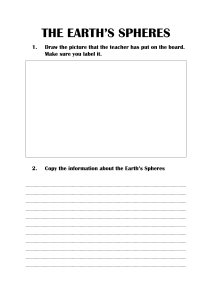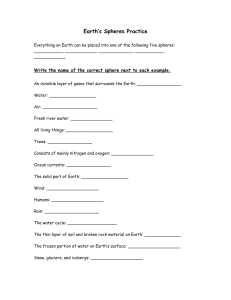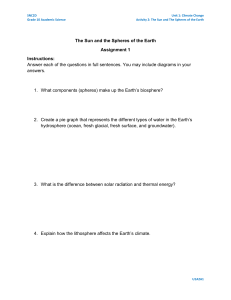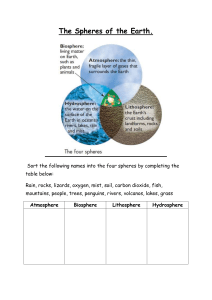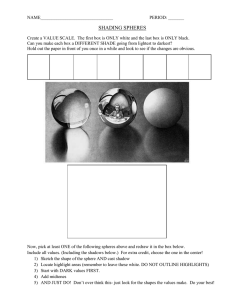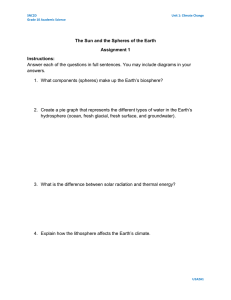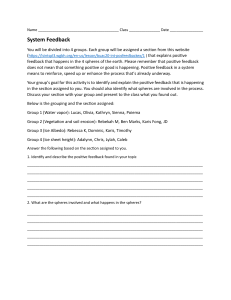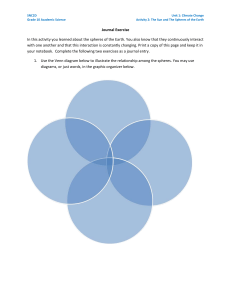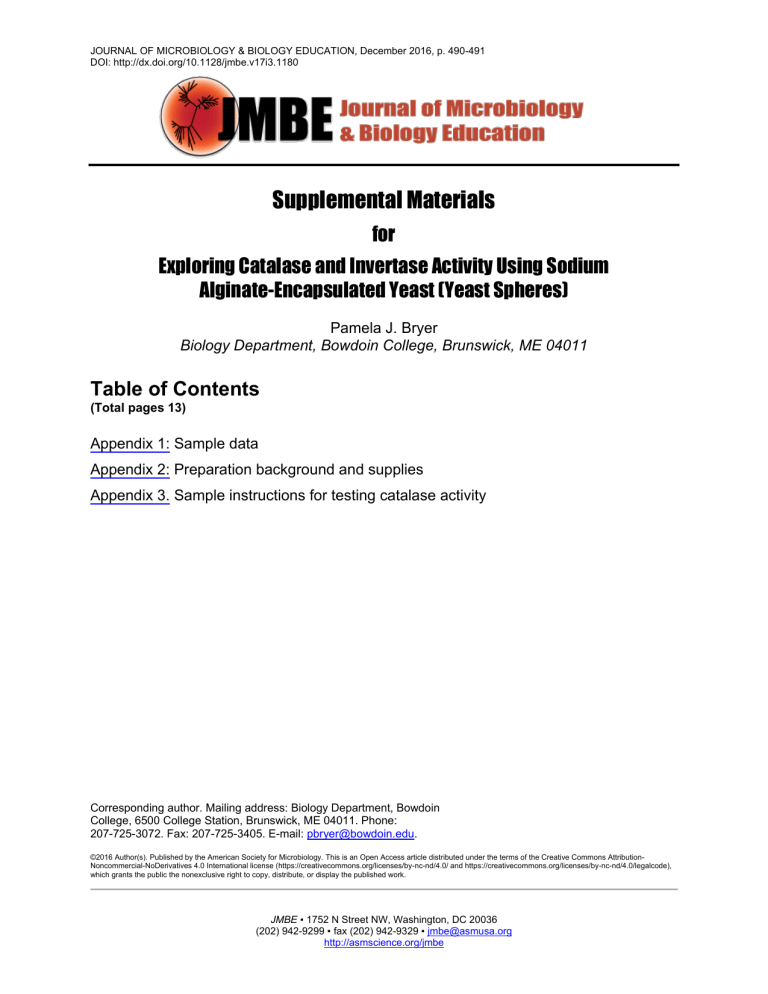
JOURNAL OF MICROBIOLOGY & BIOLOGY EDUCATION, December 2016, p. 490-491 DOI: http://dx.doi.org/10.1128/jmbe.v17i3.1180 Supplemental Materials for Exploring Catalase and Invertase Activity Using Sodium Alginate-Encapsulated Yeast (Yeast Spheres) Pamela J. Bryer Biology Department, Bowdoin College, Brunswick, ME 04011 Table of Contents (Total pages 13) Appendix 1: Sample data Appendix 2: Preparation background and supplies Appendix 3. Sample instructions for testing catalase activity Corresponding author. Mailing address: Biology Department, Bowdoin College, 6500 College Station, Brunswick, ME 04011. Phone: 207-725-3072. Fax: 207-725-3405. E-mail: pbryer@bowdoin.edu. ©2016 Author(s). Published by the American Society for Microbiology. This is an Open Access article distributed under the terms of the Creative Commons AttributionNoncommercial-NoDerivatives 4.0 International license (https://creativecommons.org/licenses/by-nc-nd/4.0/ and https://creativecommons.org/licenses/by-nc-nd/4.0/legalcode), which grants the public the nonexclusive right to copy, distribute, or display the published work. JMBE ▪ 1752 N Street NW, Washington, DC 20036 (202) 942-9299 ▪ fax (202) 942-9329 ▪ jmbe@asmusa.org http://asmscience.org/jmbe Appendix 1: Sample data. rate (cm/sec) 3 2 1 65 43 37 25 2 0 temperature oC a) rate (kPa/min) 6 4 2 0 0 20 40 temperature 60 oC b) Figure 2. Effect of temperature on the rate of yeast (Saccharomyces cervevisiae) catalase activity. Catalase activity was measured by either a) the time it took yeast spheres to rise to the top of cylinders containing different temperatures of 0.3% H2O2 or b) using gas pressure sensors with yeast spheres in different temperatures of 1.5% H2O2. Results in both methods showed that as temperature increased the enzyme activity significantly increased until 43OC where the rate then slowed (ANOVA, p<0.0001). Error bars represent SEM. 1 rate (cm/sec) 6 4 2 0. 9 0. 6 0. 3 0. 12 0 H2O2 concentration (%) a) rate (kPa/min) 10 8 6 4 2 0 0 1 2 3 H 2O2 conc (%) b) Figure 3. Effect of substrate (H2O2) concentration on the rate of yeast (Saccharomyces cervevisiae) catalase activity at room temperature. Catalase activity was measured by a) the time it took yeast spheres to rise to the top of cylinders containing different concentrations of H2O2 or b) or using gas pressure sensors with yeast spheres in different concentrations of H2O2. Results in both methods showed as concentration of H2O2 increased the enzyme activity significantly increased (ANOVA, p<0.0001). Error bars represent SEM. 2 a) rate (Δabs/sec) 0.15 0.10 0.05 0.00 0 20 40 temperature 60 80 oC b) Figure 4. The effect of temperature on yeast (Saccharomyces cervevisiae) invertase activity as measured by glucose production. Yeast spheres were immersed in 2.5% sucrose solutions at temperatures ranging from 270oC. The amount of glucose present in solution over time was measured using either a) urine analysis test sticks for glucose at 15 minutes or b) glucose oxidase at minute intervals. Results in both methods showed an increase in activity as the temperature increased. 3 a) rate (Δabs/sec) 0.15 0.10 0.05 0.00 0 5 10 sucrose conc (%) b) Figure 5. The effect of sucrose concentration on yeast (Saccharomyces cervevisiae) invertase activity as measured by glucose production. Yeast spheres were immersed in sucrose solutions at room temperature. The amount of glucose present in solution over time was measured using either a) urine analysis test sticks for glucose at 15 minutes or b) glucose oxidase at minute intervals. Results in both methods showed increase in concentration of glucose as sucrose concentration increased. 4 Appendix 2: Preparation background and supplies. Preparation background and supplies 1. Yeast spheres a. Preparation of yeast spheres i. Sodium alginate is a non-toxic hydrophilic polysaccharide that is used as a thickening agent in foods such as ice cream, yogurt, and cake mixes because it helps to emulsify oil and water and give a smooth texture to foods. It may be purchased from Flinn (S0445, 25g/$13), online from Amazon (400g/$25), or it may be found in gourmet supply stores because some chefs use it to make flavor “pearls” or “caviar” and it is also used to encapsulate yeast in the production of wine. I have found no difference in either longevity of spheres or activity between spheres made with the different sodium alginate powders. ii. I make a 2% sodium alginate solution (for 20 ml, use 0.4g/20mldH2O) a day or two day before it is to be used because it takes a long time to get into solution. I just weigh out the amount I need into a beaker or plastic cup, add dH2O (preferable to tap), stir, and leave out at room temperature. I used to put it in the refrigerator but forgot once and it was fine for days at room temperature. Because the solution is so viscous I would recommend making a separate beaker/cup for each group instead of making a big batch and trying to aliquot it out the next day. iii. I use Fleischman’s RapidRise bread yeast (Saccharomyces cerevisiae) to make a 10% yeast solution in water (10g yeast/100 ml warm water, tap is fine). Make this up about 5-10 minutes before it will be used. iv. Hydrogen peroxide may be found in the health and beauty section at most grocery or department stores, or any drugstore. It comes as a 3% solution. Be sure to use fresh as containers opened for long periods of time can lose their effectiveness. 5 v. CaCl2 is available from any science supply company. Make up enough 0.15M CaCl2 (11g/500 ml dH2O) so each group will have 50 ml. vi. Syringes (without needles) may be purchased from any Biological supply company (Carolina Biological Item #697780, Flinn #AP173). I use 30 ml syringes, but any size 5 ml or above will work. b. Yeast sphere trouble shooting i. When sodium alginate, a hydrophilic polymer, comes in contact with CaCl2, sodium ions are replaced with calcium. This leads to cross-linkages between the polymer chains and an insoluble gel is formed. If spheres with “tails” form when the yeast-sodium alginate solution comes in contact with the CaCl2 the yeast-sodium alginate solution may be too thick. If this is the case just thin it out with a bit of H2O. ii. Yeast spheres of different sizes are usually due to an uneven pressure on the syringe plunger when dropping the solution into CaCl2 so it is important to use even pressure when dropping into CaCl2. It is important for students to use spheres that are close in size for their trials. iii. Discard any floating spheres. These are usually due to an uneven suspension of the yeast-sodium alginate solution. iv. Once the yeast spheres are made they can be stored either in a plastic baggie without water, or in a beaker or plastic bag with tap water or dH2O in the refrigerator. I’ve stored them all three ways to see if activity diminishes and it doesn’t for several days no matter what way they were stored. I even left some out overnight in all three conditions and they were fine. Just be sure they don’t dry out. 2. Experiments a. Graduated cylinder method for catalase activity 6 i. Substrate concentration: I used 0.6% H2O2 (10 ml H2O2 + 40 ml dH2O), and 0.3% H2O2 (5 ml H2O2 + 45 ml dH2O) and 0.12% (2 ml H2O2 + 48 ml dH2O). Students can start with the 0.3% they used for their initial trial and decide what concentrations to use based on the timing of that trial. ii. Temperature: make sure the H2O2 and the yeast spheres are to the temperature to be tested before the experiment proceeds. Make sure students work quickly when looking at different temperatures so the temperature of the spheres or the H2O2 doesn’t get back to room temperature before they are done. The spheres may be put in water at the desired temperature to equilibrate before the experiment is conducted. iii. pH: I soaked the spheres for 5-10 minutes in the pH buffer to be tested and made the H2O2 dilutions in the pH buffer. At high and low pH the spheres may start to disintegrate if left in the buffer to equilibrate for too long. iv. Data analysis: Students may graph data either by the time it takes the yeast spheres to rise to surface or they may convert to rate of reaction by dividing the distance the spheres rose by the time. Statistical analysis (ANOVA or t-Tests) showed there was a significant difference in the reaction rate for temperature changes (rate increased as temperature increased to a point), substrate concentration (rate increased as the substrate concentration increased), and pH (rate increased as pH increased to a point) b. Gas pressure sensor method for catalase activity – Vernier gas pressure sensor and LoggerPro software was used i. Substrate concentration: I used 0.3% H2O2 (5 ml H2O2 + 45 ml dH2O), 0.6% H2O2 (10 ml H2O2 + 40 ml dH2O), 0.9% (15 ml H2O2 + 35 ml dH2O), 1.5% (25 ml H2O2 + 25 ml dH2O), 2% (33 ml H2O2 + 17 ml dH2O), and 3% (50 ml H2O2). Five grams of yeast spheres were added to an Erlenmeyer flask containing 50 ml 7 of the H2O2 concentration to be tested, the gas pressure sensor put in and data collection started. ii. Temperature: Five grams of yeast spheres were added to an Erlenmeyer flask containing 25 ml of water, pre-equilibrated to the temperature to be tested, for 5 minutes (the Erlenmeyer was in a container containing water at the temperature to be tested). 25 ml of 3% H2O2, also pre-equilibrated to the temperature to be tested was then added to the flask (final concentration H2O2 = 1.5%). The gas pressure sensor put in and data collection started. c. Urine analysis test stick method for invertase activity – Glucose test strips were purchased from Flinn Scientific (T0004, 100 strips for $19.90). Alternatively Diastix Reagent Strips for Urine Analysis may be purchased online or in a drugstore (50 strips for approximately $11) i. Sucrose concentration: five different sucrose concentrations were used (0, 1, 2.5, 5, and 10%). One gram of yeast spheres was added to 5 tubes, each containing 10ml of a different sucrose concentration. At 15 minutes after the addition of the yeast spheres a test strip was dipped into the solution surrounding the spheres, withdrawn and after 2 minutes the color was compared to the color chart included with the test strips. If cost is not an issue, the amount of glucose present at various time intervals may also be done (I did 1,3,5,10, and 15 minutes). ii. Temperature: one gram of yeast spheres was put into a tube containing 5 ml of water, pre-equilibrated to the temperature to be tested, for 5 minutes before adding to 5 ml of 5% sucrose, also pre-equilibrated to the temperature to be tested (final concentration sucrose = 2.5%). The tubes were in a Styrofoam cup containing water at the temperature being tested. At 15 minutes after the addition of the yeast spheres a test strip was dipped into the solution surrounding the spheres, withdrawn and after 2 minutes the color was compared to the color 8 chart included with the test strips. If cost is not an issue, the amount of glucose present at various time intervals may also be done (I did 1,3,5,10, and 15 minutes). d. Glucose oxidase method for invertase activity – Glucose oxidase may be purchased from VWR (#10022-658, 100 ml for $21.64). i. Sucrose concentration: five different sucrose concentrations were used (0, 1, 2.5, 5, and 10%). One gram of yeast spheres was added to 5 tubes, each containing 10ml of a different sucrose concentration. At 1, 3, 5, 10, and 15 minutes after the addition of the yeast spheres 0.2 ml of the solution surrounding the spheres was withdrawn and added to a cuvette containing 1.8ml dH2O and 1.0ml glucose oxidase. Five minutes after the addition of the sample an absorbance reading was taken with a spectrophotometer set @500nm. ii. Temperature: one gram of yeast spheres was put into a tube containing 5 ml of water, pre-equilibrated to the temperature to be tested, for 5 minutes before adding to 5 ml of 5% sucrose, also pre-equilibrated to the temperature to be tested (final concentration sucrose = 2.5%). The tubes were in a Styrofoam cup containing water at the temperature being tested. At 1, 3, 5, 10, and 15 minutes after the addition of the yeast spheres 0.2 ml of the solution surrounding the spheres was withdrawn and added to a cuvette containing 1.8ml dH2O and 1.0ml glucose oxidase. Five minutes after the addition of the sample an absorbance reading was taken with a spectrophotometer set @500nm. iii. Data analysis – graphs may be made of activity over time (abs@500nm vs time) for each condition and/or the rate (Δabs/sec) vs concentration or temperature. 3. Safety a. Both yeast and sodium alginate are considered to be non-hazardous so the yeast spheres can safely be disposed of in the trash. BSL-1 recommendations should be followed. 9 b. Calcium chloride is considered to be a mild body tissue irritant and slightly toxic by ingestion. Excess calcium chloride solution may be safely rinsed down the drain with plenty of water. 10 Appendix 3: Sample instructions for testing catalase activity. Sample Instructions for testing for catalase activity Preparing the yeast-sodium alginate solution 1. Add 20 ml of a 10% yeast (Saccharomyces cerevisiae) solution to 20 ml of a 2% sodium alginate solution (this solution is very viscous). Mix well with a glass rod or the end of an inoculating loop. 2. Draw up the yeast -sodium alginate solution into a 30 ml syringe. Carefully wipe off all excess liquid from the syringe tip. Making the yeast spheres 1. Hold the syringe or plastic pipet containing the yeast-sodium alginate solution over a beaker or cup filled 1/3-1/2 full (a minimum depth of 3 cm) with 0.15M CaCl2. Very slowly depress the plunger so that a drop of the yeast-sodium alginate solution falls into the beaker. A sphere should form as the drop comes in contact with the CaCl2 solution and fall to the bottom of the beaker. 2. Continue releasing yeast-sodium alginate drops in a steady stream into the 0.15M CaCl2 solution. The actual size of the spheres is not as important as having all spheres of uniform size. The size of the spheres may vary due to the pressure exerted on the plunger. A little practice and most spheres will be the same size. 3. The spheres should remain in this solution for about 5 minutes to harden. 4. Dispose of any floating spheres. 5. Obtain a small strainer and hold it over a clean beaker or cup. Very carefully pour the contents of the beaker containing the yeast-sodium alginate spheres into the strainer. 6. Once drained, carefully rinse the spheres under a slow running faucet or with tap water from squirt bottle. 7. Pour the spheres into a cup or beaker. If not using immediately add water so the spheres don’t dry out. 11 Testing the catalase reaction 1. Pour 50 ml of a 0.3% hydrogen peroxide (H2O2) solution into a 50 ml graduated cylinder. If this solution is not pre-made for you add 5 ml of 3% H2O2 (the concentration of purchased H2O2) to 45 ml dH2O. 2. Using forceps, or the loop end of the inoculating loop, gently remove one yeast sphere from the cup or beaker. 3. Drop the sphere into the graduated cylinder. Decide when to start timing: as soon as the sphere touches the surface of the hydrogen peroxide or as soon as it touches the bottom of the cylinder. Keep timing until the sphere reaches the surface again. 4. Dispose of the yeast sphere. 5. Do this with a few more spheres to get the timing down. Be sure to use spheres that are all the same approximate size. Designing an experiment 1. Decide what variable to test. Possibilities include substrate (H2O2) concentration, temperature, and pH. 2. Write out your experimental design. Things to think about: What is the control? What concentration(s) of substrate will be used? What temperature(s)? How many trials? How will data be displayed? 3. If using statistics to analyze your data what type(s) of statistical test should you use? 12
